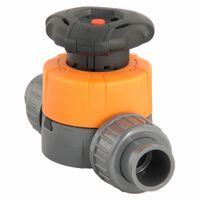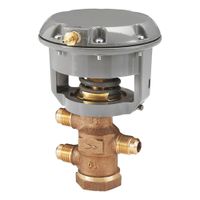Call +(254) 703 030 000 / 751 483 999 / 721 704 777
- Home
- Plumbing
- Plumbing Valves
- Shut Off Valves
- Diaphragm Valves
Diaphragm Valves
Diaphragm valves have isolated stems and are suitable for applications moving gases, liquids, and suspended solids, such as slurries. They use an elastomer diaphragm to control and throttle the flow of chemically compatible media in a system. Manual-operated diaphragm valves for chemicals open and c .....Read More
Frequently Asked Questions
What are diaphragm valves used for?
Diaphragm valves are used for controlling the flow of fluids, gases, and slurries in various industrial applications. They are particularly valued for their ability to provide a tight seal and their suitability for handling corrosive, abrasive, or viscous media. The valve operates by using a flexible diaphragm, which is pressed against a seat to stop the flow or lifted to allow flow, making it ideal for throttling and on/off control.
These valves are commonly used in industries such as pharmaceuticals, food and beverage, water treatment, chemical processing, and biotechnology. In these sectors, the valves are favored for their sanitary design, which minimizes contamination risks and allows for easy cleaning and maintenance. The absence of a packing gland in diaphragm valves eliminates the risk of leaks, making them suitable for applications requiring high purity and sterility.
Diaphragm valves are also used in applications where the media is aggressive or contains suspended solids, as the valve design prevents the media from coming into contact with the operating mechanism. This feature extends the valve's lifespan and reduces maintenance needs. Additionally, they are used in vacuum and low-pressure applications due to their excellent sealing capabilities.
In summary, diaphragm valves are versatile components used for precise flow control and isolation in a wide range of industries, particularly where cleanliness, reliability, and resistance to harsh conditions are critical.
How do diaphragm valves work?
Diaphragm valves operate using a flexible diaphragm that acts as a barrier between the flow stream and the valve's moving parts. The valve consists of a body with two or more ports, a diaphragm, and a seat or weir over which the diaphragm closes. The diaphragm is typically made of elastomeric materials or polymers, chosen based on the fluid's properties and operating conditions.
When the valve is in the open position, the diaphragm is lifted away from the seat, allowing fluid to pass through the valve. This is achieved by turning a handwheel or actuator, which moves a stem connected to the diaphragm. As the stem is raised, it pulls the diaphragm upwards, creating a clear path for the fluid.
To close the valve, the handwheel or actuator is turned in the opposite direction, pushing the stem downwards. This action presses the diaphragm against the seat or weir, effectively blocking the flow of fluid. The design ensures a tight seal, preventing leaks and contamination.
Diaphragm valves are particularly useful for handling corrosive, abrasive, or viscous fluids, as the diaphragm isolates the fluid from the valve's internal components, reducing wear and corrosion. They are also suitable for applications requiring sanitary conditions, such as in the food and pharmaceutical industries, because they are easy to clean and maintain.
The simplicity of the diaphragm valve design, combined with its ability to provide a tight seal and handle a variety of fluids, makes it a versatile choice for many industrial applications.
What materials are diaphragm valves made from?
Diaphragm valves are made from a variety of materials to suit different applications, environments, and fluid types. The primary materials used in diaphragm valves include:
1. **Body Materials:**
- **Cast Iron:** Used for general-purpose applications where cost-effectiveness is a priority.
- **Stainless Steel:** Offers excellent corrosion resistance, making it suitable for corrosive fluids and hygienic applications.
- **Plastic (PVC, CPVC, PP, PVDF):** Lightweight and resistant to a wide range of chemicals, ideal for corrosive and non-metallic applications.
- **Bronze:** Commonly used in water and steam applications due to its good corrosion resistance and durability.
- **Ductile Iron:** Provides higher strength and toughness compared to cast iron, suitable for higher pressure applications.
2. **Diaphragm Materials:**
- **EPDM (Ethylene Propylene Diene Monomer):** Offers good resistance to heat, water, and steam, suitable for non-oil-based applications.
- **PTFE (Polytetrafluoroethylene):** Known for its excellent chemical resistance and high-temperature tolerance, ideal for aggressive chemicals.
- **Nitrile (Buna-N):** Provides good resistance to oils and fuels, suitable for petroleum-based applications.
- **Viton (FKM):** Offers excellent chemical resistance and high-temperature stability, used in harsh chemical environments.
- **Neoprene:** Good for moderate chemical resistance and weathering, often used in HVAC and water applications.
3. **Lining Materials:**
- **Rubber Linings:** Used to enhance corrosion resistance and protect the valve body in aggressive environments.
- **Glass or Ceramic Linings:** Provide additional abrasion resistance for handling slurries and abrasive fluids.
These materials are selected based on factors such as chemical compatibility, temperature, pressure, and the specific requirements of the application to ensure optimal performance and longevity of the diaphragm valve.
What are the advantages of using diaphragm valves?
Diaphragm valves offer several advantages, making them suitable for various applications:
1. **Leak-proof Design**: The diaphragm acts as a barrier between the fluid and the valve body, ensuring a tight seal and minimizing the risk of leaks.
2. **Versatility**: They can handle a wide range of fluids, including corrosive, abrasive, and viscous substances, due to the availability of different diaphragm materials.
3. **Simple Construction**: With fewer moving parts, diaphragm valves are easy to maintain and have a lower risk of mechanical failure.
4. **Clean Operation**: The design prevents fluid from coming into contact with the valve's moving parts, making them ideal for hygienic applications in the food, pharmaceutical, and biotech industries.
5. **Flow Control**: They provide good throttling capabilities, allowing for precise flow regulation.
6. **Minimal Contamination**: The sealed design reduces the risk of contamination, which is crucial in sterile environments.
7. **Low Maintenance**: The simple design and fewer components result in reduced maintenance requirements and costs.
8. **Quick Operation**: They can be operated quickly, which is beneficial in processes requiring rapid response times.
9. **Flexibility**: Available in various sizes and configurations, diaphragm valves can be customized to meet specific application needs.
10. **Reduced Water Hammer**: The gradual opening and closing of the valve reduce the risk of water hammer, protecting the system from pressure surges.
11. **Cost-effective**: Generally, they are cost-effective due to their simple design and low maintenance needs.
These advantages make diaphragm valves a preferred choice in industries requiring reliable, clean, and efficient fluid control.
How do you maintain a diaphragm valve?
To maintain a diaphragm valve, follow these steps:
1. **Regular Inspection**: Periodically inspect the valve for any signs of wear, corrosion, or damage. Check for leaks around the valve body and bonnet.
2. **Cleaning**: Clean the valve and surrounding area to prevent debris from entering the valve. Use appropriate cleaning agents that do not damage the valve material.
3. **Diaphragm Check**: Regularly inspect the diaphragm for signs of wear, cracking, or deformation. Replace the diaphragm if any damage is detected to prevent leaks and ensure proper valve function.
4. **Tightening**: Ensure all bolts and nuts are properly tightened to the manufacturer's specifications. Loose components can lead to leaks and operational issues.
5. **Lubrication**: Apply suitable lubricant to moving parts if recommended by the manufacturer. Avoid over-lubrication, which can attract dust and debris.
6. **Operational Testing**: Periodically operate the valve to ensure it opens and closes smoothly. Listen for unusual noises that may indicate internal issues.
7. **Seal Inspection**: Check seals and gaskets for wear and replace them if necessary to maintain a proper seal and prevent leaks.
8. **Pressure Testing**: Conduct pressure tests to ensure the valve can handle the system's operating pressure without leaking.
9. **Documentation**: Keep detailed records of maintenance activities, including inspections, replacements, and tests. This helps in tracking the valve's condition over time.
10. **Follow Manufacturer Guidelines**: Adhere to the maintenance schedule and procedures recommended by the valve manufacturer for optimal performance and longevity.
By following these steps, you can ensure the diaphragm valve remains in good working condition, minimizing downtime and extending its service life.
What are the differences between manual and pneumatically-operated diaphragm valves?
Manual diaphragm valves are operated by hand, typically using a handwheel or lever. They require physical effort to open or close the valve, making them suitable for applications where frequent adjustments are not necessary. Manual valves are generally simpler in design, cost-effective, and require minimal maintenance. They are ideal for low-pressure systems and where precise control is not critical.
Pneumatically-operated diaphragm valves, on the other hand, use compressed air to actuate the valve. This allows for remote operation and automation, making them suitable for systems that require frequent or rapid adjustments. Pneumatic valves can be integrated into automated systems, providing precise control over fluid flow. They are ideal for high-pressure applications and environments where manual operation is impractical or unsafe.
In terms of installation, manual valves are straightforward and do not require additional components like air compressors or control systems. Pneumatic valves, however, require a source of compressed air and additional components such as solenoids and control units, which can increase the complexity and cost of the system.
Maintenance for manual valves is generally limited to periodic inspection and lubrication, while pneumatic valves may require more frequent maintenance due to the additional components involved, such as air lines and actuators.
In summary, the choice between manual and pneumatically-operated diaphragm valves depends on the specific requirements of the application, including the need for automation, frequency of operation, system pressure, and budget constraints.
How do you select the right diaphragm valve for a specific application?
To select the right diaphragm valve for a specific application, consider the following factors:
1. **Material Compatibility**: Ensure the valve body and diaphragm materials are compatible with the process fluid to prevent corrosion or degradation. Common materials include stainless steel, PVC, and PTFE.
2. **Pressure and Temperature Ratings**: Check the valve's pressure and temperature ratings to ensure they meet the application's requirements. Diaphragm valves are typically suitable for low to moderate pressure and temperature applications.
3. **Valve Size and Flow Requirements**: Determine the appropriate valve size based on the required flow rate and system pressure drop. Use flow coefficient (Cv) values to match the valve to the system's flow characteristics.
4. **Type of Diaphragm Valve**: Choose between weir-type and straight-through (or full bore) diaphragm valves. Weir-type valves are suitable for throttling and control applications, while straight-through valves are better for handling viscous or slurry fluids.
5. **Actuation Method**: Decide on manual, pneumatic, or electric actuation based on the level of automation required and the available power sources.
6. **End Connections**: Select the appropriate end connections (flanged, threaded, or welded) to match the piping system.
7. **Maintenance and Accessibility**: Consider the ease of maintenance and accessibility for diaphragm replacement, especially in systems requiring frequent servicing.
8. **Industry Standards and Certifications**: Ensure the valve complies with relevant industry standards and certifications, such as FDA, ASME, or ISO, especially in regulated industries like food and pharmaceuticals.
9. **Cost and Availability**: Balance the cost with the valve's performance and availability. Consider long-term operational costs, including maintenance and potential downtime.
10. **Supplier Reputation and Support**: Choose a reputable supplier with good customer support and availability of spare parts.
By evaluating these factors, you can select a diaphragm valve that meets the specific needs of your application.

